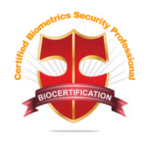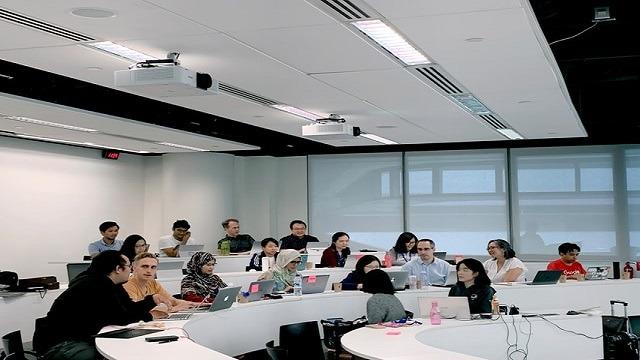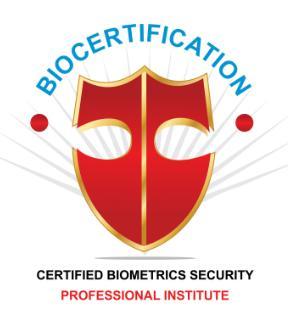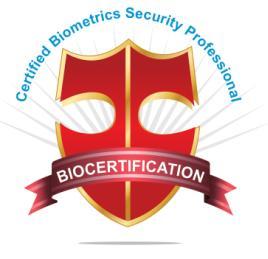
CBSP is a foundation level certification program for technology and security professionals who wish to gain a solid understanding of biometric technologies and its usage in real world applications. This program is a starting point for individuals wanting to gain a deeper knowledge of biometric technologies and applications.
Prerequisites
CompTIA Security+ training or certification is highly recommended but not required. Candidates who wish to gain knowledge in CompTIA security+ may attend our on-line course to gain the required knowledge. Please visit the link provided here.
Course Duration: 1Day
(ISC2)CPE: 8
Cost: $ 999
Course Description
CBSP is a foundation level certification program for technology professionals who wish to gain a solid understanding of biometric technologies and its usage in real world applications. This program is a starting point for individuals wanting to gain a deeper knowledge of biometric technologies and applications.
Program Objectives
Biocertification CBSP Introduction
Introduction to Biometrics
Biometrics Systems
Biometric System Performance
FBI-NGI-IAFIS
Biometric Standards
Fingerprint Recognition
Face Recognition
Iris Detection
Vein Recognition-VPR
Hand Geometry Recording
DNA Recognition
Gait Recognition
Keystroke Dynamics
Multi modal Systems
Palm Print
Privacy and Laws
Retina Scanning
Signature Biometrics
Speech and Voice Recognition
Our On-Demand
Virtual Live & Classroom Training
On-Site / Group training
Find the Event or Please Contact Us or call a sales representative for CBSP registration & schedule information.

Biocertification Training Courses Pre-Approved for CompTIA CEU’s
CE System Activity Name: Training: Other IT Industry
Max CEU’s Earned Per CE Cycle:
- CompTIA A+ – 16 CEU’s
- CompTIA Network+ – 24 CEU’s
- CompTIA Security+ – 40 CEU’s
- CompTIA CYSA+ – 40 CEU’s
- CompTIA Linux+ – 40 CEU’s
- CompTIA CASP – 60 CEU’s
If the training pertains to a CompTIA certification (A+, Security+…) please use the following:
CE System Activity Name: Training: CompTIA Certification CAQC-Approved
Max CEU’s Earned Per CE Cycle:
- CompTIA A+ – 16 CEU’s
- CompTIA Network+ – 24 CEU’s
- CompTIA Security+ – 40 CEU’s
- CompTIA CYSA+ – 40 CEU’s
- CompTIA Linux+ – 40 CEU’s
- CompTIA CASP – 60 CEU’s
CE Submission Requirements:
Individuals must upload the following information into their Candidate Record in order for training to be approved:
• Date of training program
• Number of training hours
• Training completion certificate from the training provider
CE Submission Requirements:
Individuals must upload the following information into their Candidate Record in order for training to be approved:
• Date of training program
• Number of training hours
• Training completion certificate from the training provider
CE Activity Guidelines:
- If renewing a ‘certified for life’ certification then training must have been completed within 90 days prior to enrolling in the CE program or within the 3 year CE cycle.
- If renewing a ‘ce’ certification training must have been completed within the 3 year CE cycle.
| Biometrics – Course Titles | A+ | Network+ | Security+ | CASP |
| Certified Biometrics Security Professional | APPROVED | APPROVED | APPROVED | APPROVED |
| Certified Biometrics Security Technician | APPROVED | APPROVED | APPROVED | APPROVED |
| Certified Biometrics Security Engineer | APPROVED | APPROVED | APPROVED | APPROVED |


